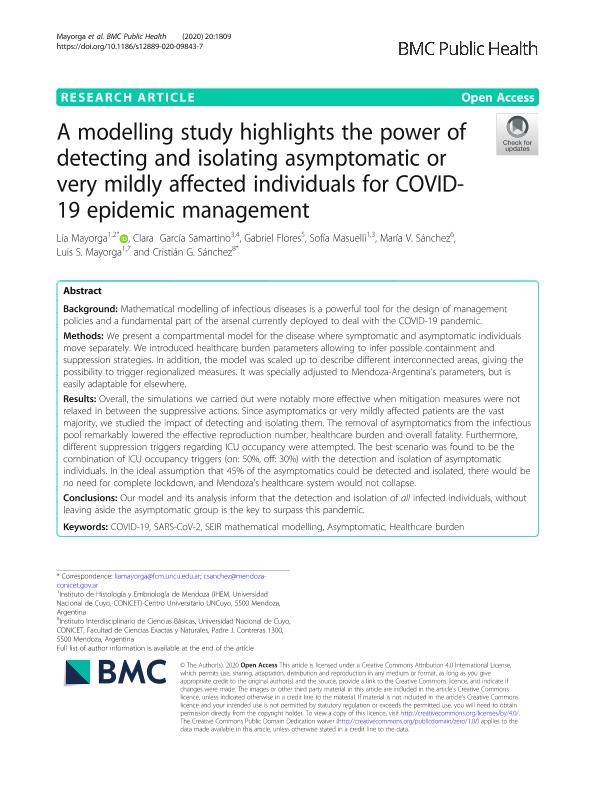Artículo
A modelling study highlights the power of detecting and isolating asymptomatic or very mildly affected individuals for COVID-19 epidemic management
Mayorga, Lía ; García Samartino, Clara; Flores, Gabriel; Masuelli, Sofía
; García Samartino, Clara; Flores, Gabriel; Masuelli, Sofía ; Sanchez Sanchez, Maria Victoria
; Sanchez Sanchez, Maria Victoria ; Mayorga, Luis Segundo
; Mayorga, Luis Segundo ; Sánchez, Cristián G.
; Sánchez, Cristián G.
 ; García Samartino, Clara; Flores, Gabriel; Masuelli, Sofía
; García Samartino, Clara; Flores, Gabriel; Masuelli, Sofía ; Sanchez Sanchez, Maria Victoria
; Sanchez Sanchez, Maria Victoria ; Mayorga, Luis Segundo
; Mayorga, Luis Segundo ; Sánchez, Cristián G.
; Sánchez, Cristián G.
Fecha de publicación:
12/2020
Editorial:
BioMed Central
Revista:
BMC Public Health
ISSN:
1471-2458
Idioma:
Inglés
Tipo de recurso:
Artículo publicado
Clasificación temática:
Resumen
Background: Mathematical modelling of infectious diseases is a powerful tool for the design of management policies and a fundamental part of the arsenal currently deployed to deal with the COVID-19 pandemic. Methods: We present a compartmental model for the disease where symptomatic and asymptomatic individuals move separately. We introduced healthcare burden parameters allowing to infer possible containment and suppression strategies. In addition, the model was scaled up to describe different interconnected areas, giving the possibility to trigger regionalized measures. It was specially adjusted to Mendoza-Argentina’s parameters, but is easily adaptable for elsewhere. Results: Overall, the simulations we carried out were notably more effective when mitigation measures were not relaxed in between the suppressive actions. Since asymptomatics or very mildly affected patients are the vast majority, we studied the impact of detecting and isolating them. The removal of asymptomatics from the infectious pool remarkably lowered the effective reproduction number, healthcare burden and overall fatality. Furthermore, different suppression triggers regarding ICU occupancy were attempted. The best scenario was found to be the combination of ICU occupancy triggers (on: 50%, off: 30%) with the detection and isolation of asymptomatic individuals. In the ideal assumption that 45% of the asymptomatics could be detected and isolated, there would be no need for complete lockdown, and Mendoza’s healthcare system would not collapse. Conclusions: Our model and its analysis inform that the detection and isolation of all infected individuals, without leaving aside the asymptomatic group is the key to surpass this pandemic.
Archivos asociados
Licencia
Identificadores
Colecciones
Articulos(IHEM)
Articulos de INST. HISTOLOGIA Y EMBRIOLOGIA DE MEND DR.M.BURGOS
Articulos de INST. HISTOLOGIA Y EMBRIOLOGIA DE MEND DR.M.BURGOS
Articulos(IMBECU)
Articulos de INST. DE MEDICINA Y BIO. EXP. DE CUYO
Articulos de INST. DE MEDICINA Y BIO. EXP. DE CUYO
Articulos(IQUIBICEN)
Articulos de INSTITUTO DE QUIMICA BIOLOGICA DE LA FACULTAD DE CS. EXACTAS Y NATURALES
Articulos de INSTITUTO DE QUIMICA BIOLOGICA DE LA FACULTAD DE CS. EXACTAS Y NATURALES
Citación
Mayorga, Lía; García Samartino, Clara; Flores, Gabriel; Masuelli, Sofía; Sanchez Sanchez, Maria Victoria; et al.; A modelling study highlights the power of detecting and isolating asymptomatic or very mildly affected individuals for COVID-19 epidemic management; BioMed Central; BMC Public Health; 20; 1; 12-2020; 1-11
Compartir
Altmétricas



